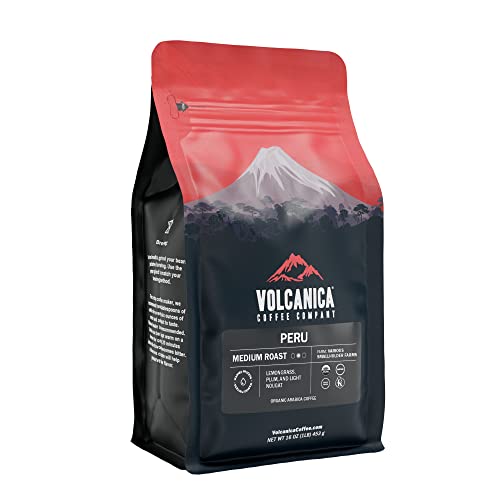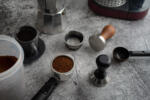Peru coffee facts: Quick Glance
- Coffee Flavor Profile: Crisp hint of acidity, medium body, vibrant floral aromas, rich sweetness.
- Processing Method: Wet Process, Washed
- Main Growing Regions: Amazonas, Ayacucho, Cusco, Huánaco
- Harvest time: June through September
Introduction
Coffee is one of the top commodities in the world. There are coffee shops in almost every corner of every city today. Just visit any city you think of, and you will be surprised to see how coffee shops are strategically positioned. That is a good reason to tell you there are many coffee lovers across the globe. Are you one of the coffee aficionados?
Table Of Contents
−- Peru coffee facts: Quick Glance
- Introduction
- Is Peru known for coffee?
- The history of Peruvian coffee
- Peruvian coffee in Europe
- The current state of the Peruvian coffee industry
- Peruvian coffee growing facts
- Major growing regions and their beans
- What does Peruvian coffee taste like?
- Is Peruvian coffee strong?
- Why drink coffee from Peru?
- How to buy the best Peruvian coffee beans
- Best Peruvian coffees
- Roasting and brewing Peruvian coffee
- Conclusion
Brazil top the list of coffee producers that ensure coffee lovers across the globe enjoy a cup of coffee every day. If you love coffee, chances are you have enjoyed Brazilian coffee.

Is Peru known for coffee?
Besides Brazil, there is another critical coffee producer; although it does not appear among the best five producers, it contributes mainly to producing exemptional beans. That producer is no other than Peru.
In 2017, Peru stood at position ten in the list of the world’s largest coffee producers. That is a good reason enough to show you that Peruvian coffee is no underdog. Cultivating over 3.2 billion 60kg bags of delicious coffee each year and being the second-highest exporter of fair-trade coffee to Mexico, it is worth learning more about Peruvian coffee. So let’s start with its history.
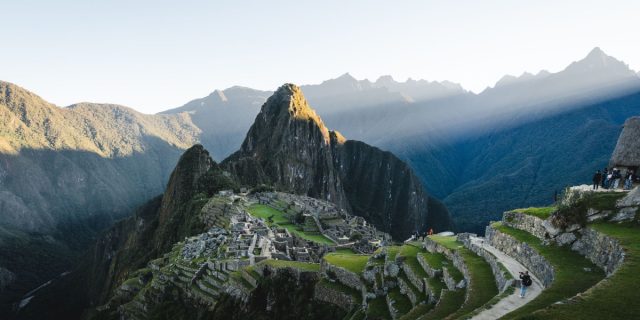
The history of Peruvian coffee
The coffee beans reached Peru years ago and adapted quickly to Peru’s conditions. That is around the mid-1700s. Since then, Peruvian coffee has grown steadily to become one of the coffees loved by many across the globe.

Peruvian coffee in Europe
The late 1800s were not the best years for countries like Indonesia and its neighbors. A terrible disease affected the growth of coffee in these countries, triggering European buyers to look for alternative producers worldwide to quench Europe’s insatiable demand for coffee. And it was during that period that Peruvian coffee was found. This discovery contributed significantly to the growth of healthy Peruvian coffee and its economy.
England also accepted over 2 million hectares of coffee-growing land as payment for a defaulted loan and started plantation-like farms. Unfortunately, England later sold its land during the world wars and this, in many ways, affected the growth of Peruvian coffee. One area that was hard hit is the ability of Peru to export coffee. But despite all these challenges, Peruvian coffee has continued to put a smile on the faces of many coffee lovers.
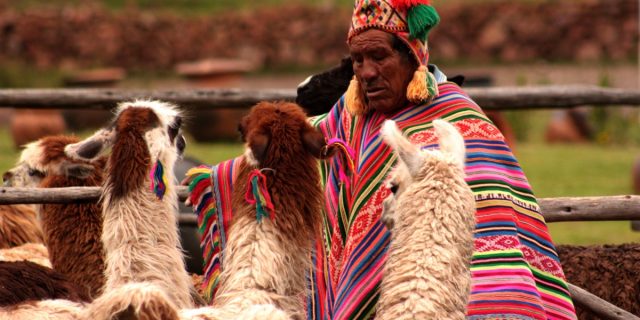
The current state of the Peruvian coffee industry
Like most top coffee producers that have continued to up their game in coffee production over the years, Peru coffee also has a promising future. It has progressed positively towards both healthy production and high-quality beans.
This progress has placed Peru in a position to flex muscles with top coffee producers like Brazil and Colombia. Today, Peru has over 100 000 farmers, with a significant percentage growing traditional, shade-grown Arabica beans that are quickly becoming well-respected in the international market.
The wet processing process has contributed significantly to the quality of current Peru’s coffee beans. Not forgetting the efforts of co-ops. The growth of firm cooperatives supporting farmers has led to a positive change in the quantity of organic and fair-trade coffee beans produced each year.
More Information
- Peru’s coffee industry generates over 855 000 jobs in otherwise remote, impoverished areas.
- The US is the top market for Peruvian coffee, accounting for 24% of the total exports.
- Peru is still in the process of recovering from the rust infestation that hit almost have of its coffee plantations in 2014.
- The government, through DEVIDA encourages coffee production as an alternative crop to coca leaf cultivation.

Peruvian coffee growing facts
- Coffee was first brought to Peru in the 1700s.
- It is one of the largest producers of certified organic, Rainforest Alliance certified, and UTZ certified coffee. Visit the International Federation of Organic Agriculture Movements (IFOAM) to learn more about other certified producers of certified organic coffee.
- Farmers belong to local cooperatives, which help their beans reach a larger audience and get much fairer prices for their beans. Through these co-ops, local farmers can demand a decent living and fair wage for their hard work.
- Peruvian coffee is pure of the Arabica type. 70%of which is Typica, and 20% is Carurra, with the remaining 10% spread across other varieties.
- The coffee is selected by hand, which can come the higher the elevation with considerable danger. Then, the cherries are washed and dried in the sun to extract the pulp from the beans. Usually, Peruvian coffee is processed dry, but there is also a small market for wet processing.
- International Coffee Organization (ICO) positions Peru as the 9th largest coffee producer globally, with 223,902 families dedicated to the industry.
- Peruvian coffee tends to be medium body coffee. They are also mellow and pleasant with mild acidity. You cannot resist the rich sweetness this coffee offers.
- Peru’s coffee producing regions are Amazonas, Ayacucho, Cajamarca, Cusco, Huánuco, Junín, Pasco, Piura, Puno, and San Martín.

Major growing regions and their beans
Now let’s look at some of the foremost coffee-growing regions in Peru and the beans that come from those regions. Ready to learn more?
- Capis Coffee
Have you ever heard about the animal poop coffee in Peru? If yes, that is another name for Capis coffee. The coatis are allowed to eat the fruits of coffee, and after a few hours (four to six), they defecate. The beans are then picked, washed, roasted, and grounded. All this results in expensive coffee loved by many people across the globe.
- Urubamba Beans
Urubamba beans are grown in the country’s southern regions near the famous Machu Picchu and Cusco locations. These beans have an enchanting aroma and are smooth and wet-processed.
- Chanchamayo Beans
Grown on the eastern side of the Andes Mountains’ imposing heights and the Amazon basin’s edge, these beans are light to medium body and mild to bright acidity. Compared to beans from other locations, Chanchamayo beans are of the highest quality and are often organic.
A cup of Chanchamayo coffee carries more decadent chocolate and nutty qualities and a bright, sweet, citrusy presence from the first olfactory whiff to the final satisfying aftertaste.
- Quechua Coffee
Grown in Puno, Quechua coffee is one of the best coffees you will ever have. Its quality is excellent and has even won global awards like Global Specialty Coffee Expo in Seattle!
- Uchunari Coffee
They are located in the forests near Pisac. Uchunari coffee is also known as Peruvian poop coffee. But this coati poop is particularly sought after because it is the key to making Peruvian poop coffee. Some Peruvian coffee producers have turned to coatis to make a unique type of coffee. They attract a variety of wild animals when coffee cherries mature and turn red.
What does Peruvian coffee taste like?
Low-altitude farms in Peru, like those found around the town of Nambale near the border between Peru and Ecuador, tend to produce coffee with mild acidity, medium body, and smooth notes of nuts, flowers, and gentle fruit.
Once you go up into the Andes, including farms around Cusco and Machu Picchu, the coffee begins to feature a vivid acidity, bright floral aromas, and a rich sweetness. But, again, these are more likely to be specialty beans and those for which we compete against other roasters.
Such two flavor profiles are pretty popular.
We also see several exceptional beans going beyond these generalizations. They seem to come out of nowhere, but if you look a little closer, the reason is apparent: many farmers who were once constrained by poor infrastructure now can let their coffees shine for the international market. That’s fun for us, and we can’t wait to find more of these beans.
A good Chanchamayo’s taste is smooth and delicate, very well balanced with nutty and chocolate tones, a sweet taste of citrus in flavor and aroma, and a pleasant finish/aftertaste. The taste is sweet and smooth.
Is Peruvian coffee strong?
Due to its excellent yet understated nature, Peru is typically a mildly acidic coffee, light-bodied yet flavorful and aromatic. Peru is also widely used as a base for flavored coffees in dark roast blends.
Why drink coffee from Peru?
It’s always about the profile, and the same way that connoisseurs talk about wine is coffee.
Peruvian coffee often has a medium body, a medium between watery and syrupy. Mexican coffee often has a light body, for example, and is more watery due to the low altitude it grows at. Meanwhile, Sumatra coffee is known to have a heavy body and more syrupy mouthfeel due to the nutrients in the soil where it thrives.
Cuppers (professional coffee tasters) refer to Peruvian coffee with a mild acidity as aromatic and flavourful. That means a couple of things.
You’ll know when it’s the good stuff when you turn on the brewer, and it starts heating up. If you prefer brewing with Chemex or French press, you will be able to smell it when it’s ready to sip.
When coffee is called “flavorful,” it does not apply to any artificial additives or may even have a “burnt” or “non-burnt” flavor. Instead, it absorbs nutrients and minerals from the soil, depending on where coffee is produced, giving the brew a natural flavor. In the case of Peru’s soil, your buds will pick up some chocolate, nutty notes, and even some citrus notes, not just during a hearty sip but also in the smell and aftertaste.
How to buy the best Peruvian coffee beans
You can buy a bag of Peruvian coffee, but if it’s not the quality stuff, you won’t get the real sense of what drinking this delicious caffeinated beverage means.
So, make sure you buy 100% Arabica first and foremost. Robusta is used to make Vietnamese coffee. They own their method of coffee making, which includes sweetened condensed milk, but using any other form of coffee preparation won’t tickle your taste buds.
I’m saying that robusta is gross unless the circumstances are right. Make sure your bag is not cut with robusta, which many retailers do to reduce costs.
Most of Peru’s coffee is grown at least 1,200 meters above sea level, but the better, the higher. Most coffee is grown in the mountains of the Andes and Chanchamayo, with well-respected elevations and quality of production.
Best Peruvian coffees
- Tres Cumbres – Peru Coffee (Volcanica)
These medium-roasted coffee beans are sourced from the Chanchamayo region and grown right on the sloped of the Andes. When brewed, they deliver a full-bodied coffee with light acidity and a bright finish.
- Cafe Tunki (Owens Coffee Roasters)
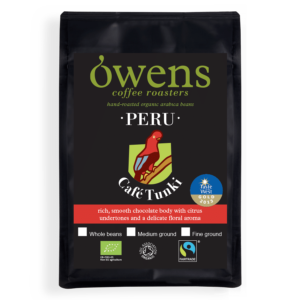
Another great Peruvian coffee to try is Café Tunki. It is a product of Owens Coffee Roasters, a UK-based company. This single-origin coffee is grown on a farm organically certified and approved by the Rainforest Alliance. Its beans are dark roasted and exude a creamy, nutty flavor, a smooth, chocolaty body, and citric acidity.
[su_button url=”https://owenscoffee.com/collections/single-origin-coffee/products/tunki” target=”blank” background=”#bb6b24″ size=”13″ radius=”0″ rel=”nofollow”]Go to their site[/su_button]
- Peru Coffee (Sweet Maria’s)
Are you looking forward to roasting some of the Peruvian coffee? Look no further because Sweet Maria’s green coffee beans are the best option. You can roast them to your satisfaction and remember they come and go with alarming speed. So be ready to shop immediately if they are available in the market.
[su_button url=”https://www.sweetmarias.com/green-coffee/south-america/peru.html” target=”blank” background=”#bb6b24″ size=”13″ radius=”0″ rel=”nofollow”]Check out their site[/su_button]
Roasting and brewing Peruvian coffee
There are two types of Peruvian coffee suitable for brewing coffee. That is a medium roast and dark roast. Medium roast draws out the beans’ original toasted, grainy flavor, while dark roast brings out the natural components of the flavor profile and the floral aroma.
Peruvian coffee is not machine-specific. You can brew it using any method you are an expert in. However, for the best experience, we recommend using an espresso machine, drip machine, or the Pour Over method.
Conclusion
Although not the largest producer of coffee in the world, Peru coffee is still one of the best organic coffee you will ever have. These medium roasted beans deliver a complex, full-bodied coffee with light acidity and a bright finish not offered by many coffees.
Disclaimer: This post contains affiliate links, which means I may receive a small commission, at no extra cost to you, if you make a purchase using these links. Remember to support us by purchasing through the Amazon/Walmart/Impact Radius links provided. Last update on 2024-04-18 / Affiliate links / Images from Amazon Product Advertising API
Disclosure: No compensation or free products were received in exchange for writing this review.

Editorial Staff
The editorial staff at Crazy Coffee Crave is a team of coffee enthusiasts & Baristas who enjoy the one thing we all think about as soon as we get up in the morning. Trusted by thousands of readers worldwide.

